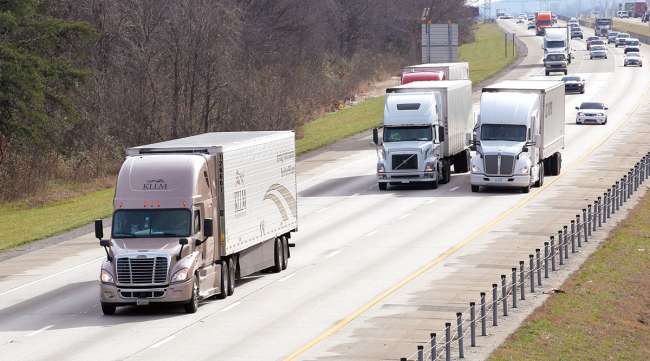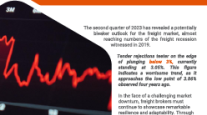Staff Reporter
Spot Market Remains Suppressed Amid Stubborn Capacity

[Stay on top of transportation news: Get TTNews in your inbox.]
The trucking spot market has remained in a down cycle for more than a year as the number of trucks and drivers diminished — albeit at a slower rate than the decline in overall freight demand.
DAT Freight and Analytics reported the number of weekly load posts on its platform fell 8.6% week-to-week to 598,674 for the week ending Feb. 24. The last time load posts dropped below 600,000 was during the COVID-19 pandemic lockdowns in April 2020. The total number of load posts also was down 59% year-over-year.
“We’re still seeing some carriers hang in there because they’ve got no other choice,” said Dean Croke, principal analyst with DAT. “They are trying to finance a note on a truck that’s worth a third of what it was, so they’ve got to keep running. There’s a lot of other carriers out there that are just hanging in there because they know things will turn and then there’s a bunch of carriers who can run for $1.50 a mile and still be quite OK.”
Croke pointed out that the load-to-truck ratio at 1.02 loads per truck is nearing the 0.84 rate seen when demand collapsed at the beginning of the pandemic. He also noted that the pandemic causing a wide range of operating costs is a major reason why capacity is leaving slowly. He also doesn’t foresee enough capacity leaving to influence the next market cycle.

Croke
“In a normal market cycle, there would be a significant exodus, and the market would turn,” Croke said. “But because of this wide range of operating costs, I think we’re going to see it’ll be just a slow exodus of carriers this year. I think that the only thing that’s going to change it is any sort of change in demand. I think it’s more on the demand side that’s going to change this next market cycle, and there’s not a lot of good news there.”
Stifel Capital Markets analyst Bruce Chan noted that the broader trucking market is oversupplied with capacity. He has seen spot rates get close to all-time lows. He suspects they likely bottomed at some point between the third and fourth quarters but remain at depressed levels.
“Rates are very low,” Chan said. “Inflation has impacted their costs. ... Everything from maintenance [and tires to insurance has] escalated quite significantly. So they’re facing a lot of pressure, and we have started to see, or continue to see, the pace of exits and net revocations grow. So capacity is coming out of the market, but not at a rate sufficient to correct the supply-demand imbalance.”

Chan
Truckstop and FTR Transportation Intelligence reported that there have been further declines in broker-posted spot rates for dry van and refrigerated equipment for the week ending Feb. 23. But their report also found overall rates rose on strength in flatbed. This led to rates increasing 0.8% despite a 2.1% decline in demand and a 1.5% increase in the supply of trucks.
“The spot market has returned all the way back down to historic norms,” said Brent Hutto, chief relationship officer at Truckstop. “What we went through in the pandemic with the historic expansion in the number of carriers that are for-hire, the amount of freight that was in the marketplace, the rates that went in the marketplace, it was expanded so long [that] it’s going to take a long time for it to work out when you consider that you’ve got additional capacity.”

Hutto
Hutto pointed out that spot rates returning to more traditional levels is coming up against higher operating costs between fuel and inflation. This puts owner-operators in a tight spot financially. He said the spot market has been going through this down cycle for about 16 months.
“The for-hire capacity that came into the market, they weren’t a hundred-truck fleets,” Hutto said. “They were one, two, three truck owners. They were firmly owner-operators, and owner-operators can adjust their business. They can take side jobs; they can do all kinds of things to continue to keep in business until things return to a better rate environment for them.”
Hutto also has seen that many of the owner-operators that have left the spot market also were the ones that entered it toward the tail end up the up cycle. That means the owner-operators hanging on will be less likely to leave since they are the ones that positioned themselves to withstand the down cycle when the market was strong.
“I’d be looking at the old principle of last in, first out,” Hutto said. “The carriers that came in at the very tail end of the pandemic when rates were high were most likely the ones that were first out. We saw that because we saw a lot of expedited haulers come in, we saw a lot of truck drivers that had not been in the market that long that jumped over to independent, and those were the first ones out because in the end, it is a business, and you have to make a profit.”
Want more news? Listen to today's daily briefing below or go here for more info:




